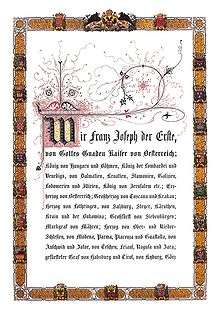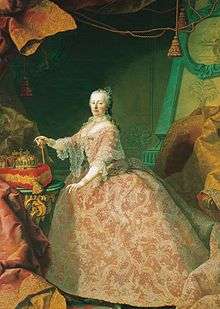Grand title of the Emperor of Austria


The Grand title of the Emperor of Austria was the official list of the crowns, titles, and dignities which the emperors of Austria carried from the foundation of the empire by Francis II, Holy Roman Emperor's imperial proclamation of August 11, 1804 until the end of the monarchy in 1918.
After the House of Habsburg established itself in the 11th century, it grew in power. Various domains were added to its empire in central, eastern and western Europe. The throne of the Holy Roman Empire was continuously occupied by the Habsburgs between 1438 and 1740, and again between 1745 and the dissolution of the Holy Roman Empire in 1806. The house also produced monarchs of the Kingdoms of Bohemia, Germany, Hungary, Croatia, Portugal, Spain, and (jure uxoris) of England and Ireland, as well as rulers of several Dutch and Italian principalities amongst many others.
The Austrian Empire was declared as the Holy Roman Empire dissolved itself and became a successor state. The former Holy Roman Emperor Francis II became the Emperor of Austria. In accordance with tradition and the titles that were already held, he promulgated the grand title to codify the most important monarchical titles of various countries and territories under Habsburg rule, and also of titular rulers of former possessions. With the Austro-Hungarian Compromise of 1867 the grand title was again slightly modified. Although the Austrian emperor was also the nominal head of the German Confederation, this was not included in the grand title since it was an elected office.
The grand title was not a complete listing of all the titles held; instead it ends with an etc. There were also a middle title and a small title.
The empress, as consort of the emperor, was also given the feminine version of the title.
Grand title
The full title (in German) of the Austro-Hungarian monarch as of 1914 was:
- Seine Kaiserliche und Königliche Apostolische Majestät
- von Gottes Gnaden Kaiser von Österreich,
- König von Ungarn und Böhmen, von Dalmatien, Kroatien, Slawonien, Galizien, Lodomerien und Illyrien;
- König von Jerusalem etc.;
- Erzherzog von Österreich;
- Großherzog von Toskana und Krakau;
- Herzog von Lothringen, von Salzburg, Steyer, Kärnten, Krain und der Bukowina;
- Großfürst von Siebenbürgen, Markgraf von Mähren;
- Herzog von Ober- und Niederschlesien, von Modena, Parma, Piacenza und Guastalla, von Auschwitz und Zator, von Teschen, Friaul, Ragusa und Zara;
- Gefürsteter Graf von Habsburg und Tirol, von Kyburg, Görz und Gradisca;
- Fürst von Trient und Brixen;
- Markgraf von Ober- und Niederlausitz und in Istrien;
- Graf von Hohenems, Feldkirch, Bregenz, Sonnenberg etc.;
- Herr von Triest, von Cattaro und auf der Windischen Mark;
- Großwojwode der Woiwodschaft Serbien
- etc., etc.[1][2]
which translates to:
- His Imperial and Royal Apostolic Majesty,
- By the Grace of God Emperor of Austria,
- King of Hungary and Bohemia, Dalmatia, Croatia, Slavonia, Galicia, Lodomeria and Illyria;
- King of Jerusalem, etc.;
- Archduke of Austria;
- Grand Duke of Tuscany and Cracow;
- Duke of Lorraine, Salzburg, Styria, Carinthia, Carniola and Bukovina;
- Grand Prince of Transylvania, Margrave of Moravia;
- Duke of Upper and Lower Silesia, of Modena, Parma, Piacenza and Guastalla, of Auschwitz and Zator, of Teschen, Friaul, Ragusa and Zara;
- Princely Count of Habsburg and Tyrol, of Kyburg, Gorizia and Gradisca;
- Prince of Trent and Brixen;
- Margrave of Upper and Lower Lusatia and in Istria;
- Count of Hohenems, Feldkirch, Bregenz, Sonnenberg etc.;
- Lord of Trieste, of Cattaro and on the Windic March;
- Grand Voivode of the Voivodeship of Serbia
- etc., etc.
Subsequent use
After 1918, the Grand Title was invoked for historical commemorative reasons in two Habsburg burial ceremonies in Vienna.
At the burial of Zita, the last Empress (1916–18), on 1 April 1989 in the imperial mausoleum, three prayers were said for the deceased by a speaker commissioned by the family, before the gate was opened and the sarcophagus was borne into the mausoleum. The first prayer started with the feminine form of the Grand Title: "Zita, Empress of Austria, crowned Queen of Hungary, Queen of Bohemia ...". In the list of duchess titles, the title of Duchess of Parma claimed by the Habsburgs was omitted, as she had a closer tie to Parma. Her father, Robert of Parma, was the last Duke of Parma (1854-1860) and as a pretender to that title she was a Princess, even though she was not born until 1892. Thus at the end of the list of titles was inserted, "Infanta of Spain, Princess of Portugal and of Parma".
Zita's son Otto von Habsburg was buried on 16 July 2011, and a prayer was said in the mausoleum: "Otto of Austria, first Crown Prince of Austria-Hungary, royal prince of Hungary and Bohemia ..." The titles of King of Jerusalem and Archduke of Austria were omitted. No Austrian Emperor was actually sovereign over Jerusalem, and in 1961 Otto had renounced all claims of sovereignty in the Republic of Austria.